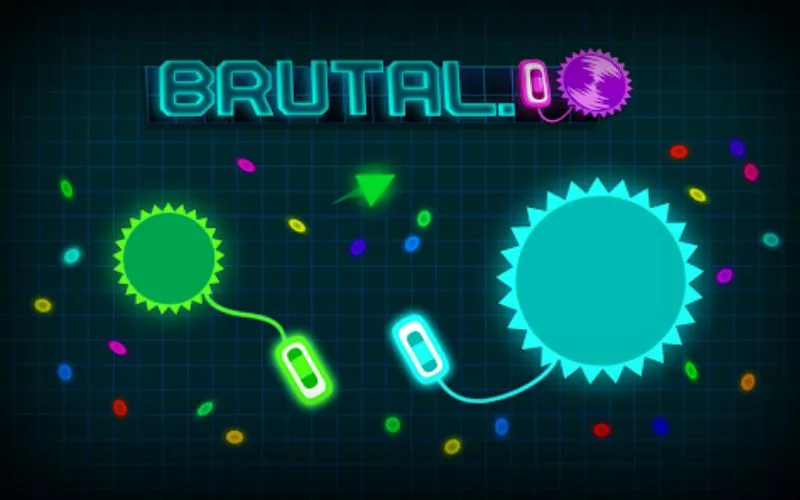io game has taken the gaming world by storm, captivating players with its simple yet addictive mechanics. These games, characterized by their multiplayer environments and easy accessibility, have evolved significantly since their inception. From the early days of minimalistic graphics to the complex, engaging gameplay we see today, io games have become a staple in the online gaming community, drawing millions of players worldwide.
In this exploration, we delve into the various types of io games, from battle royale to puzzle genres, highlighting the unique features that set them apart. We will also examine gameplay mechanics that enhance player interaction, the vibrant communities that have formed around these games, and the innovative design processes that developers employ to create memorable gaming experiences.
Definition of IO Games

IO games are a genre of online multiplayer games characterized by their simplicity, accessibility, and real-time competition. They often feature basic graphics and mechanics, allowing players to jump into the action without lengthy tutorials or complicated controls. The term “IO” originates from the domain of the first popular game in this genre, Agar.io, where “io” stands for the domain extension for the British Indian Ocean Territory. These games have captivated a broad audience, providing a unique blend of competitive play and social interaction.
The core characteristics of IO games include minimalistic gameplay, easy-to-understand mechanics, and large player bases competing in real-time. Players can often grow an avatar or entity by consuming smaller opponents while avoiding larger threats. Many IO games operate on a free-to-play model, monetizing through ads or microtransactions. Examples of popular IO games include Agar.io, Slither.io, and Diep.io, each offering distinct gameplay mechanics that emphasize survival, strategy, and skill.
Evolution of IO Games
Over the years, IO games have evolved significantly, from their simple beginnings to more complex and varied gameplay experiences. Initially, titles like Agar.io introduced players to the concept of eating smaller entities to grow larger while avoiding being consumed. This fundamental mechanic laid the groundwork for subsequent games that expanded upon similar themes.
The evolution of IO games can be summarized in several key phases:
- Early Concepts: The first wave of IO games focused on simplistic mechanics, emphasizing player-versus-player interactions in a confined space. Agar.io and Slither.io featured basic graphics and straightforward controls, making them immediately accessible to players worldwide.
- Increased Complexity: Following the success of the early titles, developers introduced more complex mechanics and varied gameplay styles. Games like Diep.io added elements of strategy and customization, allowing players to upgrade their capabilities and introduce a level of depth previously unseen in the genre.
- Diverse Themes: Later iterations of IO games branched into various themes, moving beyond the original eating mechanics. Titles like Krunker.io adopted first-person shooter mechanics, while others incorporated elements of role-playing and puzzle-solving, showcasing the versatility of the genre.
- Community and Social Features: Modern IO games have increasingly focused on community building, incorporating features such as clans, leaderboards, and social interactions that enhance the competitive experience among players.
The landscape of IO games continues to change, with developers pushing boundaries and introducing innovative mechanics that will shape the future of the genre. As technology advances, the potential for more immersive and interactive experiences is limitless, ensuring that IO games will remain a staple in the online gaming community.
Types of IO Games
IO games have captivated a significant audience with their diverse gameplay styles and competitive nature. Each genre of IO games offers a unique experience that appeals to various player preferences, whether they crave intense competition, strategic planning, or casual play. Understanding these genres can help players choose the games that best fit their gaming style.
The landscape of IO games is broad, encompassing several genres, each with distinct characteristics and gameplay mechanics. From fast-paced battle royales to thought-provoking puzzles, these games ensure that there is something for everyone. Below, we explore different genres of IO games, highlighting their unique features and popular titles that exemplify each type.
Battle Royale IO Games
Battle royale IO games focus on survival in a progressively shrinking arena, where players compete against each other until one remains. These games often feature a mix of strategic planning and real-time combat, emphasizing quick reflexes and tactical decision-making. Players typically start with minimal gear, scavenging for weapons and resources to eliminate opponents.
- Examples: “Diep.io” is a standout in this genre, allowing players to control tanks, upgrade their abilities, and engage in chaotic battles against others. Another popular title is “Agar.io,” where players grow by consuming smaller cells while avoiding larger ones.
Puzzle IO Games
Puzzle IO games combine problem-solving with competitive elements, challenging players to think critically while racing against others. These games often require players to complete tasks or solve puzzles faster than their opponents, making them perfect for those who enjoy mental challenges.
- Examples: “WormsZone.io” is a fascinating puzzle IO game where players control a worm that grows by eating food, navigating a field full of opponents. “Slither.io” also falls within this realm, requiring players to avoid crashing into others while strategically growing their worm.
Strategy IO Games
Strategy IO games emphasize careful planning, resource management, and tactical maneuvering. Players often build and manage resources while competing against others, requiring a mix of foresight and adaptability to outsmart opponents.
- Examples: “Little Big Snake” allows players to grow their snake and conquer territories while strategically leading attacks against rivals. “Lordz.io” combines strategy with real-time battles, enabling players to build armies and fortify their kingdoms to defeat foes.
“Each genre of IO games offers a unique experience that appeals to various player preferences, whether they crave intense competition, strategic planning, or casual play.”
By understanding these various types of IO games, players can not only enhance their gaming experience but also discover new favorites that align with their individual tastes. Each genre brings its own flavor to the IO gaming world, ensuring endless entertainment and competition.
Gameplay Mechanics
The essence of IO games lies in their innovative gameplay mechanics that foster engagement and interaction among players. These mechanics are designed to create a dynamic gaming environment where resource gathering, player interactions, and strategic gameplay are integral components. By leveraging these elements, IO games offer a distinct experience that sets them apart from traditional gaming formats.
Resource gathering is a cornerstone of many IO games, enabling players to collect materials or points that contribute to their growth within the game. This process can take various forms, such as harvesting resources from the environment or defeating other players to acquire their items. The immediacy and simplicity of collecting resources create a compelling loop that encourages continuous play. Players are incentivized to explore and dominate their surroundings, which leads to heightened engagement.
Common Gameplay Mechanics
Several gameplay mechanics are prevalent across IO games, each contributing to the unique experience that defines the genre. Understanding these mechanics enhances appreciation for the games’ design and player interactions.
- Resource Gathering: Players often need to collect resources to build, upgrade or maintain their in-game presence. This can mean gathering items like food, materials, or points, which contribute to player strength and capabilities.
- Player Interactions: Interaction with other players is a defining characteristic of IO games. These interactions can be cooperative, competitive, or neutral, influencing both strategy and gameplay dynamics.
- Progression Systems: Many IO games employ progression systems where players level up or unlock new abilities as they gather resources and interact with others. This sense of progression encourages prolonged engagement.
- Real-Time Action: The fast-paced, real-time nature of IO games emphasizes quick decision-making and reflexes, setting them apart from the turn-based mechanics found in traditional games.
- Minimalist Design: The simplicity of design and mechanics in IO games allows players to quickly understand and engage with the game, lowering barriers to entry compared to more complex traditional games.
The interplay of these mechanics not only fosters competition but also cultivates a vibrant community atmosphere. Players must adapt to the ever-changing dynamics of the game, often leading to unexpected alliances or rivalries. The real-time aspect of gameplay creates an adrenaline rush, as participants must think on their feet to survive and thrive.
When comparing IO game mechanics to traditional video games, significant differences emerge. Traditional games often rely on structured levels, narrative progression, and predetermined interactions. In contrast, IO games offer a sandbox environment where player decisions and interactions dictate the flow of the game. This leads to a more organic and unpredictable gaming experience, fostering a sense of agency and involvement that is sometimes lacking in traditional formats.
The mechanics in IO games reflect a shift towards community-driven gameplay, where player interactions and resource competition create a constantly evolving narrative that is unique to each session. This makes IO games not just entertainment but a platform for social interaction and creative expression.
Community and Multiplayer Aspects

The rise of IO games can largely be attributed to their vibrant online communities and dynamic multiplayer environments. These games facilitate player interaction on a global scale, fostering a sense of camaraderie and competition that keeps players coming back for more. The blend of simple mechanics and social elements creates an engaging experience, appealing to a diverse audience of gamers.
Online communities play a crucial role in the ongoing popularity of IO games. These communities not only provide a platform for players to connect and share experiences, but they also contribute to the game’s longevity through user-generated content and active discussions. Players often gather on forums, social media, and streaming platforms to share strategies, celebrate achievements, and organize tournaments, creating a sense of belonging that enhances their gaming experience.
Multiplayer Dynamics and Player Interactions
In IO games, multiplayer dynamics are fundamental to gameplay, as they encourage real-time interactions among players. The competitive nature of these games results in various player interactions, ranging from alliances to rivalries. Players must navigate these relationships to achieve their objectives, leading to a rich and immersive experience.
Key elements of multiplayer dynamics in IO games include:
- Real-Time Competition: Players compete against each other continuously, which heightens the excitement and unpredictability of the game. This real-time aspect keeps players engaged and coming back to improve their skills and rankings.
- Team Play: Many IO games allow players to form teams or clans, fostering cooperation and strategy formulation. Teamwork can significantly enhance performance and create a more enjoyable experience for players.
- Social Interaction: Chat features and online forums enable players to communicate with one another, allowing for strategy discussions and socializing, which adds depth to the game.
The competitive environment of IO games is often amplified by leaderboards and in-game achievements, which serve as benchmarks for player success. These features not only motivate players to improve but also create a sense of community as players celebrate their rankings and milestones together.
Impact of Leaderboards and Achievements
Leaderboards and achievements are vital components that significantly influence player engagement in IO games. They not only reward skill and dedication but also create a competitive atmosphere that encourages players to strive for excellence.
The effects of leaderboards and achievements include:
- Motivation: Leaderboards provide players with clear metrics of their performance relative to others, driving them to improve their skills and climb the ranks.
- Community Recognition: Achievements often come with visibility on leaderboards, giving players recognition within the community. This acknowledgment fosters pride and encourages continued participation.
- Friendly Competition: The presence of a ranking system instills a spirit of friendly competition, pushing players to play more often and aim for higher scores.
In summary, the interplay of community engagement and multiplayer dynamics, enhanced by leaderboards and achievements, plays a significant role in the sustained popularity of IO games. These elements create an ecosystem where players feel connected, competitive, and motivated to improve their gaming skills.
Development and Design of IO Games
The development and design of IO games involve a meticulous process that transforms initial concepts into engaging, multiplayer experiences. The dynamic nature of these games requires a keen understanding of both gameplay mechanics and the technical framework needed to support them, ensuring that players are captivated and return for more.
The process begins with ideation, where developers brainstorm unique concepts and gameplay styles. Once a solid idea is established, prototyping follows, allowing developers to create a basic version of the game to test its core mechanics. This phase is crucial for identifying strengths and weaknesses early on. After successful testing, the game enters full development, which includes designing graphics, user interfaces, and soundscapes, alongside intensive coding to bring the game to life.
Technical Requirements and Challenges
The technical landscape of IO games encompasses several critical requirements and challenges that developers must navigate. These include:
- Server Infrastructure: Reliable servers are essential for handling multiple players simultaneously. Scalability is vital, as a sudden influx of users can lead to performance issues.
- Cross-Platform Compatibility: Many IO games aim to be accessible across various devices and browsers. This requires adherence to web standards and optimization for different screen sizes.
- Real-Time Multiplayer Functionality: Implementing real-time interactions necessitates robust networking solutions to minimize latency and ensure smooth gameplay.
- Graphics Optimization: Given the need for quick loading times, developers must balance high-quality graphics with performance, often employing techniques such as sprite sheets and lower-resolution assets.
These challenges necessitate thorough testing and optimization to deliver a seamless user experience.
Successful Design Elements Enhancing User Experience
Design elements play a critical role in enhancing the user experience in IO games. Developers often incorporate specific features that resonate well with players, fostering engagement and retention. Key elements include:
- Intuitive Controls: Games with simple, responsive controls allow players to jump in quickly and feel immediately engaged, minimizing the learning curve.
- Visual Feedback: Responsive animations and effects provide players with instant feedback on their actions, reinforcing a sense of accomplishment and progression.
- Customization Options: Allowing players to personalize their characters or avatars not only enhances engagement but also promotes a sense of ownership.
- Leaderboards and Achievements: Competitive elements like leaderboards foster a sense of rivalry among players, encouraging them to improve and play more frequently.
These design choices contribute significantly to the overall enjoyment and replayability of IO games, making them a staple in the gaming community.
Marketing Strategies for IO Games
In the dynamic world of online gaming, the marketing strategies employed for IO games play a crucial role in their success. With the fast-paced growth of the gaming industry, it becomes essential to adopt innovative approaches to capture the attention of potential players. This segment explores effective strategies that have proven successful in promoting IO games, emphasizing the significance of social media and streaming platforms, as well as sharing notable case studies.
Effective Marketing Strategies
A well-structured marketing strategy can significantly enhance the visibility and appeal of IO games. Developers often utilize a mix of digital marketing techniques, including:
- Influencer Collaborations: By partnering with popular gaming influencers on platforms like YouTube and Twitch, developers can reach a broader audience. Influencers can showcase gameplay, generating excitement and attracting their followers to try the game.
- Social Media Campaigns: Engaging content on platforms such as Twitter, Instagram, and Facebook can create buzz around new releases. Developers often share sneak peeks, behind-the-scenes content, and interactive posts that encourage user participation and sharing.
- Community Engagement: Building a strong community through forums, Discord servers, and Reddit can help foster loyalty. Active engagement with players, including feedback sessions and Q&A events, can make players feel valued and invested in the game.
- Cross-Promotion: Collaborating with other gaming titles, particularly within the same genre, can introduce games to new audiences. Sharing promotional content or featuring characters from one game in another can drive mutual interest.
The Role of Social Media and Streaming Platforms
Social media and streaming platforms have become pivotal in the marketing of IO games. The interaction and engagement these platforms provide are unparalleled. Developers leverage these tools not only for promotion but also for community building and real-time feedback.
“Social media is not just a marketing tool; it’s a channel for community-building and player engagement.”
Streaming platforms like Twitch and YouTube Gaming offer unique opportunities for developers to reach potential players directly. Live streams allow real-time interaction, where developers can answer questions and showcase new features. As a result, players feel more connected to the game and its developers.
Case Studies of Successful Marketing Campaigns
Examining successful marketing campaigns provides insights into effective strategies for IO games. Notable examples include:
- Agar.io: Launched in 2015, Agar.io’s minimalist design and addictive gameplay went viral largely through social sharing. Its marketing strategy heavily relied on influencers and YouTubers who demonstrated the game, leading to organic growth and a massive player base.
- Slither.io: Similar to Agar.io, Slither.io utilized social media to attract players. The game featured a simple concept that made it easy to share experiences online, coupled with memes and engaging content that resonated with audiences, driving massive traffic to the game.
- Diep.io: The developers of Diep.io created a dedicated Facebook page and actively engaged with users through updates, memes, and community feedback. This direct interaction fostered a loyal player base and encouraged word-of-mouth marketing.
Future Trends in IO Gaming
The IO gaming industry is poised for significant evolution as it adapts to changing player preferences and advancements in technology. With an increasing focus on accessibility, social interaction, and immersive experiences, the future of IO games looks promising. As developers explore new frontiers, several trends are likely to shape the landscape of IO gaming over the coming years.
Emerging Trends in Gameplay and Interaction
The evolution of gameplay mechanics and player interaction is set to revolutionize IO gaming. Players are seeking deeper, more meaningful experiences, which will lead to the emergence of sophisticated game designs that integrate narrative elements and player-driven choices. These trends may include:
- Richer Narratives: Developers are expected to introduce story-driven elements that give context to the game world, enabling players to connect with their characters on a more personal level.
- Increased Customization: Future IO games may offer extensive character and gameplay customization, allowing players to tailor their experiences to their preferences.
- Dynamic Environments: Interactive and evolving game worlds could become more common, where player actions directly influence the environment and gameplay dynamics.
Technological Advancements Influencing IO Games
Several technological advancements have the potential to redefine IO gaming experiences. As the industry embraces new technologies, the following innovations are expected to play a crucial role:
- Artificial Intelligence: Advanced AI can create more responsive and adaptive game environments, allowing for enhanced player interactions and smarter NPC behavior.
- Cloud Gaming: With the rise of cloud technology, players may enjoy high-quality gaming experiences without the need for powerful hardware, broadening accessibility.
- Cross-Platform Play: As the demand for cross-platform gaming grows, IO games will likely become more inclusive, allowing players on different devices and platforms to interact seamlessly.
Impact of Mobile and VR Platforms on IO Gaming
The rise of mobile and virtual reality (VR) platforms is reshaping how players engage with IO games. The following factors highlight the significance of these platforms:
- Mobile Gaming Dominance: With the increasing prevalence of smartphones, IO games optimized for mobile play are expected to dominate, offering quick and easy access for casual gamers.
- Immersive VR Experiences: As VR technology matures, developers may create immersive IO games that provide players with a unique, first-person perspective, enhancing engagement and enjoyment.
- Augmented Reality Integration: The integration of augmented reality elements can create hybrid experiences, allowing players to interact with the game world in real-world settings.
The ongoing advancements in technology and shifts in player behavior will redefine the boundaries of IO gaming, fostering a more engaging and diversified gaming environment.
Concluding Remarks: Io Game

In conclusion, the landscape of io games continues to evolve, reflecting changing player preferences and technological advancements. As we look to the future, it’s clear that the combination of community engagement, innovative gameplay, and effective marketing strategies will play a crucial role in shaping the next generation of io gaming. With the rise of platforms like mobile and VR, the potential for growth and new experiences within this genre is limitless, promising exciting developments for players and developers alike.
If you’re looking for a fun and creative way to engage with your kids, discovering toca boca free options can be a game-changer. These games encourage imaginative play and offer a variety of activities that will keep young minds entertained for hours. With many free resources available, parents can easily introduce their children to the joy of Toca Boca without breaking the bank.
If you’re looking for a fun and creative way for your kids to play, consider exploring toca boca free. This app offers a range of engaging activities that stimulate children’s imaginations while allowing them to interact with various characters and environments. It’s a fantastic resource for parents who want to encourage creative play without any cost involved.


